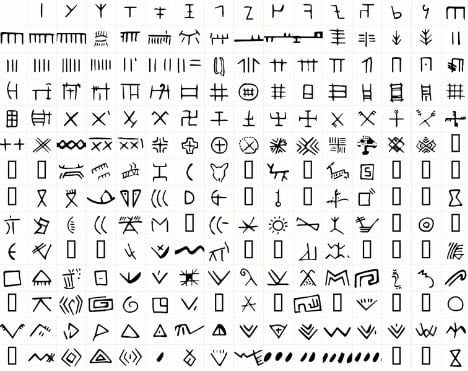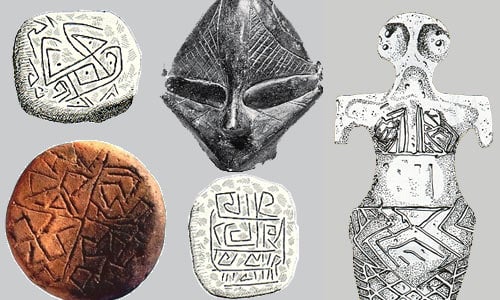Is the Danube Valley Civilization script the oldest writing in the world?
The Danube Valley civilization is one of the oldest civilizations known in Europe. It existed from between 5,500 and 3,500 BC in the Balkans and covered a vast area, in what is now Northern Greece to Slovakia (South to North), and Croatia to Romania (West to East).
During the height of the Danube Valley civilization, it played an important role in south-eastern Europe through the development of copper tools, a writing system, advanced architecture, including two storey houses, and the construction of furniture, such as chairs and tables, all of which occurred while most of Europe was in the middle of the Stone Age. They developed skills such as spinning, weaving, leather processing, clothes manufacturing, and manipulated wood, clay and stone and they invented the wheel. They had an economic, religious and social structure.
One of the more intriguing and hotly debated aspects of the Danube Valley civilization is their supposed written language. While some archaeologists have maintained that the ‘writing’ is actually just a series of geometric figures and symbols, others have maintained that it has the features of a true writing system. If this theory is correct, it would make the script the oldest written language ever found, predating the Sumerian writings in Mesopotamia, and possibly even the Dispilio Tablet, which has been dated 5260 BC.

Danube Valley Civilization Artifacts (image source)
Harald Haarmann, a German linguistic and cultural scientist, currently vice-president of the Institute of Archaeomythology, and leading specialist in ancient scripts and ancient languages, firmly supports the view that the Danube script is the oldest writing in the world. The tablets that were found are dated to 5,500 BC, and the glyphs on the tablets, according to Haarmann, are a form of language yet to be deciphered. The symbols, which are also called Vinca symbols, have been found in multiple archaeological sites throughout the Danube Valley areas, inscribed on pottery, figurines, spindles and other clay artifacts.

The Vinca Symbols (Source: Wikipedia)
 The implications are huge. It could mean that the Danube Valley Civilization predates all other known civilizations today. Evidence also comes from thousands of artifacts that have been found, such as the odd-looking figure displayed on the left. However, the majority of Mesopotamian scholars reject Haarmann’s proposal, suggesting that the symbols on the tablets are just decoration. This is despite the fact that there are approximately 700 different characters, around the same number of symbols used in Egyptian hieroglyphs. Other scholars even suggested that the Danube Civilization must have copied signs and symbols from the Mesopotamian civilizations, despite the fact that some of the Danube tablets have been found to be older that the Mesopotamian ones.
The implications are huge. It could mean that the Danube Valley Civilization predates all other known civilizations today. Evidence also comes from thousands of artifacts that have been found, such as the odd-looking figure displayed on the left. However, the majority of Mesopotamian scholars reject Haarmann’s proposal, suggesting that the symbols on the tablets are just decoration. This is despite the fact that there are approximately 700 different characters, around the same number of symbols used in Egyptian hieroglyphs. Other scholars even suggested that the Danube Civilization must have copied signs and symbols from the Mesopotamian civilizations, despite the fact that some of the Danube tablets have been found to be older that the Mesopotamian ones.
It appears that this is another case of a theory based on solid research being outright rejected without appropriate consideration. Could this be because it conflicts with the accepted view of which nation holds claim to the ‘first civilization’? At the very least, Haarmann’s proposal deserves further research and serious analysis in order to confirm whether this is indeed the oldest known written language in the world.
Featured image (image source)
By John Black
Related Links
Introduction to the Danube Script
The Old European Script – Further Evidence




















Comments
Lmao this is the most dogshit theory that i have ever read and this site is perfect for you qanon type mongoloids who would fall for any 2-bit charlatan that comes your way.
first of all, there was no danubian “civilization”. the danubian culture was a catch-all term coined by arcaheologists to group together a myriad of cultures in the area (of which the vinca culture that produced these vinca symbols was lumped into) which did not constitute a state in any meaning of the word.
you have to ask yourselves, why would anyone invent writing in the first place? myths and religion, cultural touchstones, in fact anything important to society can be perserved through oral tradition. no, the only thing that would require the precision and unambiguity of writing is the will of a sovereign, being exercised through his servants of state. in all societies which invented writing, writing was initially monopolised by scribes who would act as a a caste of bureaucrats for the state’s sovereign.
no matter how technologically advanced the danubian cultures were, they simply did not have the state apparatus that was necessary for the invention of writing. and that is a good thing as it meant that the danubians lived a far less oppressed life than their mesopotamian contemporaries.
God Bless America
I think it's funny that some Mesopotamian scholars believe the symbols on the tablets are just decoration... Correct me if i'm wrong, but didn't scholars first believe that cuneiform was just decorations as well? These very well might be just for decoration, but just to blow it off like that is crazy.
Funny, as I looked on the pic above with letters, instantly I started to connect old-hungarian abc (known as "rovás") to the new hungarian abc (based on latin). For some of the symbols I can even tell not just the letter, but the standalone meaning of it as well. I also see some ligature and forms of thing in our writing, we call it "összerovás". Our old writing is not too strict, if you would like to shorten the length of script, you can "write letters together", and it's a free-style stuff. There is only a few baseline rules for "összerovás", for example the created mark must be as clear as possible, making others able to read it as well (if you wish). Add into this, that in our language only consonents carry the information. Vowels are only fillings. How do you know it? Here is a word. "Szeretlek" - it means love. If you swap vowels, just a few example: sziritlik, szörötlök, szurutluk, szürütlük. If you say it out loudly, a speaker of my language will understand it in all of these forms. Therefore it's not a surprise, that in texts, scripts written thousands ago, in them the vowels are missing. Good luck for deciphering the secrets of findings without our help. It worked fine while deciphering secrets of sumer language (what you claim is the oldest known written language or so). And I'm not an expert guys, I'm just a regular everyday normal guy.
Oldest siting is Lepenski vir(8000 BC) in which was found proto-Vincan script. Antropologicaly, people who lived there were Cromagnons-Dinarics. Vinca was continuity of Lepenski vir and Starcevo cultures, with same alphabet and same antropogicaly and racialy people, with same agriculture and architecture. Difference between these cultures is that Vinca is "evoluted" Lepenski vir, with a bit modern form of writting, farming, building and with a advance metalurgy. Dinaric Cromagnons originated in the Dinaric Alps and lived throughout the Balkans and central Europe towards east since last ice age. Y-chromose haplogroup of Dinarics is I2 in all its varieties. I2 haplogroup has its peak among the South Slavs- the land in which originated. This shows us that there was not a 7th century migration of Slavs because racialy and antropologicaly and geneticaly same people are living in the Balkans in prehistory and today.
These symbols depicted here from wiki are symbols from both paleolitic protowrittings and neolitic writtings, it means those symbols are from a few mileniums not from the same time. From the latets form of Vincan alphabet which is from some 4000-3000 yrs BC there are 27 identical letters in medieval and modern Serbian alphabet. A little reminder, the oldest known written Slavic language is Serbian language from Greek Macedonia and its called Church-Slavic. This tells us that old Serbian language is same like old Slavic language from which Ruski, Polski, Czeski are born. Pavel Jozef Safarik also noticed and clame this. In the 1980s in Yugoslavia was Paleo-Slavic institute which was investigating Vinca, Lepenski vir and at the time 54 more(today there are over a 100) neolitic and paleolitic sites in Serbia. Their conclusion was that there was no Slavic migrations and that Serbs have linguistic and antropological continuity since prehistory. Institute was imediately closed by the comunist regime. Radivoj Pesic, linguistician, deciphered Vincan script, using Slavic(Serbian) language. He continued his work out broad because Yugoslavia didnt had interes in showing the real history. Etruscan(Raseni) alphabet was deciphered by Svetislav Bilbija and it is the same language and alphabet like Vincan with 2 letters written opposite. Even the Minoan Cretean linear writting were deciphered using the same Slavic(Serbian) language. Today Mario Alinei, European leading linguistician clame that Vincan, Etruscan, Cretean civilisations are Slavic. He is supported by his colleague Tomecoli, Klosov and Nortvedh who are geneticians and linguisticians and who clame evidence both from genetic and linguistic researches.
For all my neighbouring nations, you can clame some ancient roots only by admiting your Serbian roots. Romanians are fake nation, created in 19th century by uniats. Romanians, most of them have Slavic origin which is supported by the cirilic writtings in Slavic language up to the 19th century in Romania. Rab Boziji Vlad Cepes is clearly not some Latin inscription. Bulgars have only the name, while language is clearly Serbian with no knowleadge of gramar. Dacians were the non Roman empire Slavs and Ilirians were Roman empire Slavs, while Thracians were non Greek influenced Slavs. I do not believe those paleolitic and neolitic Dinarics called themselves Serbs, but Nino Belov-biblical Nimrod was tittled in Asyria as the Lord emperor of Serbs-Ur Nina Sar Serburla in 2000 BC. And we all know that Nino Belov started his Arian conquest from Balkans, from the citty of Nisa, modern Nis. Even the swords that were found and that are displayed in Baghdad museum are from some Serbian Morava river valley metalurgy workshop. Serbian name derived from God Serbon-Sun god and Serbona-Moon goddes. Serbian coat of arms also like name is from this deity, and Serbian coat of arm can be tracked since Lepenski vir culture.
good the Google Play Store. As soon as you're able to surf, https://iplaystoreapp.com Play Store purchase you would love to make nice.
Pages